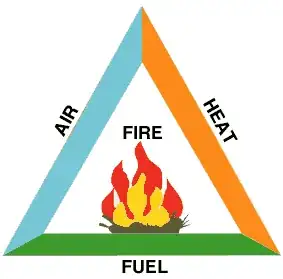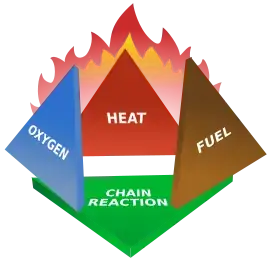What you have to remember with regard to fires, is the fire triangle.

All three legs of the triangle are needed in order to support a fire. Take away one (or more) of the legs and fire does not exist. There are some circles of thought that say a more accurate visual for fire is the fire tetrahedron.

Basically this adds "chain reaction" to the bottom of the triangle which stands for the process of fire. For example, halon removes the "chain reaction" side by combining with active hydrogen molecules.
Now, when you think about your server room, it's easier to see how all sides of this triangle can and do exist.
- AIR: Oxygen is readily available - unless you're like me and fart a lot replacing O2 with methane.
- HEAT: Again, many things in a server room give off heat...why do you think servers are so LOUD?
- FUEL: This is perhaps the most confounding part of your question and deserves the bulk of my answer below.
When most of us think about "fuel", we think about gasoline or paper, not things that are normally found in a server room in sufficient quantities. If paper and gasoline is found in sufficient quantities in your server room, then perhaps you have bigger issues, but I digress.
Fuel can take many different forms. It might help to see the classifications of fires:
- Class A: Regular combustibles like wood, paper, etc.
- Class B: Flammable liquids or gases like natural gas, propane, etc.
- Class C: Electrical fires (or energized electrical equipment).
- Class D: Flammable metals like magnesium, aluminum, sodium, lithium, etc.
Most of these classifications are found on fire extinguishers so it's obvious what kinds of fires you can put out with what kinds of extinguishers. One thing you wouldn't want to do is use the incorrect extinguisher on the wrong fire...dire things happen.
Now believe it or not, server rooms contain many things that are fuels. As has been mentioned in other threads, PCB boards, wiring, plastic, aluminum, magnesium, oil (in your sliding server rails), varnishes (on your wooden furniture), wood, foam, lithium (in batteries), etc., etc.
Most things, given enough O2 and heat will burn. Once a fire has started, nasty things begin to take place. Burning material gives off all kinds of nasty gases (more fuel) which in turn burns hotter and in different locations now because your air conditioning units are doing their jobs by keeping air moving in your server room. Couple this with the fact that server rooms are designed around air flow (with raised floors, wiring runs, etc.) and it becomes easier to see how quickly things can get out of shape.
Once some metals catch on fire, they can be extremely difficult to extinguish. Traditional fire suppressing materials (normally found in server rooms) won't put metal fires out. In fact, adding water (a very traditional fire fighting substance) will, in all probability, aggravate the fire so much, that it appears that it's exploded on the application of water.

